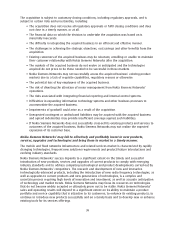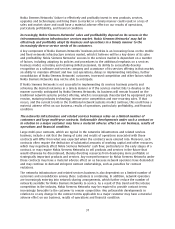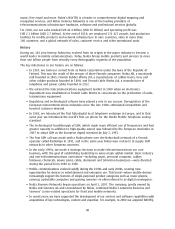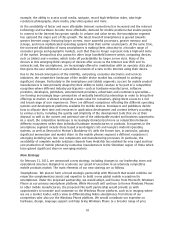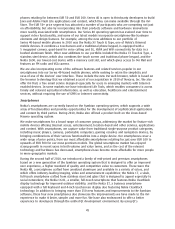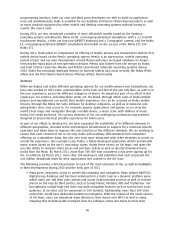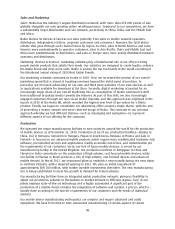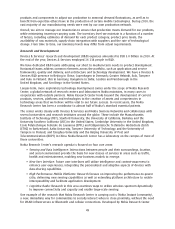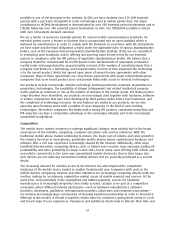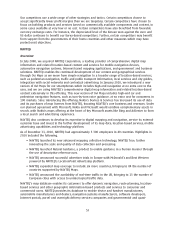Nokia 2010 Annual Report Download - page 44
Download and view the complete annual report
Please find page 44 of the 2010 Nokia annual report below. You can navigate through the pages in the report by either clicking on the pages listed below, or by using the keyword search tool below to find specific information within the annual report.example, the ability to access social media, navigate, record highdefinition video, take high
resolution photographs, share media, play video games and more.
As the availability of faster and more affordable Internet connections has increased and the relevant
technology and hardware become more affordable, demand for mobile products that enable people
to connect to the Internet has grown rapidly. In volume and value terms, the smartphone segment
has captured the major part of this growth. The latest breed of smartphones is geared towards
greater Internet usage, featuring larger screens, more powerful processors, greater memory and
storage, and more sophisticated operating systems than their earlier counterparts. At the same time,
the increased affordability of many smartphones is making them attractive to a broader range of
consumer groups and geographic markets, such that they no longer represent only a highend niche
of the market. Demand has also grown for other large handheld Internetcentric computing devices,
such as tablets and ereaders, which trade off pocketability for larger screen sizes. Many of the
devices in this emerging third category of devices offer access to the Internet over WiFi and 3G
networks and, like smartphones, are increasingly offered in combination with an operator data plan
that gives the user unlimited or a predefined amount of access to the Internet using their device.
Due to the broad convergence of the mobility, computing, consumer electronics and services
industries, the competitive landscape of the mobile device market has continued to undergo
significant changes. Particularly in the smartphone and tablets segments, success for mobile product
manufacturers is now primarily shaped by their ability to build, catalyze or be part of a competitive
ecosystem where different industry participants—such as hardware manufacturers, software
providers, developers, publishers, entertainment providers, advertisers and ecommerce specialists—
are forming increasingly large communities of mutually beneficial partnerships in order to bring their
offerings to market. A vibrant ecosystem creates value for consumers, giving them access to a rich
and broad range of user experiences. There are different ecosystems reflecting the different operating
systems and development platforms available for mobile devices. Developers and publishers decide
how to allocate their time and resources in application development and content delivery according
to various criteria, including the quality and simplicity of the development tools that are at their
disposal as well as the current and potential size of the addressable market and business opportunity.
As a result, the competitive landscape is increasingly characterized more as competition between
different ecosystems rather than individual hardware manufacturers or products. Ecosystems in the
smartphone segment include those based around Apple’s iOS and Google’s Android operating
systems, as well as Research in Motion’s Blackberry OS, with the former two, in particular, gaining
significant momentum and market share. In the mobile phones segment a different ecosystem is
emerging involving very low cost components and manufacturing processes. In particular, the
availability of complete mobile solutions chipsets from MediaTek has enabled the very rapid and low
cost production of mobile phones by numerous manufacturers in the Shenzhen region of China which
have gained significant share in emerging markets.
New Strategy
On February 11, 2011, we announced a new strategy, including changes to our leadership team and
operational structure designed to accelerate our speed of execution in an intensely competitive
mobile products market. The main elements of our new strategy are as follows.
Smartphones:
We plan to form a broad strategic partnership with Microsoft that would combine our
respective complementary assets and expertise to build a new global mobile ecosystem for
smartphones. Under the proposed partnership, we would adopt, and license from Microsoft, Windows
Phone as our primary smartphone platform. While Microsoft will continue to license Windows Phones
to other mobile manufacturers, the proposed Microsoft partnership would provide us with
opportunities to innovate and customize on the Windows Phone platform, such as in imaging where
we are a market leader, with a view to differentiating Nokia smartphones from those of our
competitors who also use the Windows Phone platform. We would contribute our expertise on
hardware, design, language support and help bring Windows Phone to a broader range of price
43





